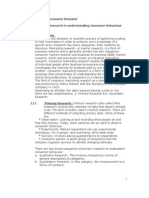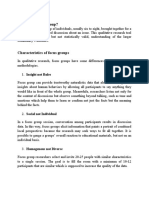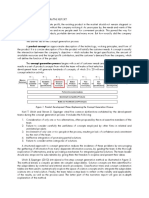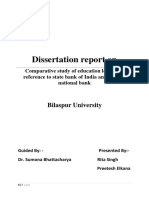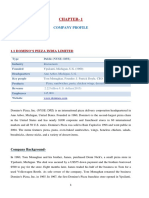Focus Group
Focus Group
Uploaded by
AmadaLibertadCopyright:
Available Formats
Focus Group
Focus Group
Uploaded by
AmadaLibertadCopyright
Available Formats
Share this document
Did you find this document useful?
Is this content inappropriate?
Copyright:
Available Formats
Focus Group
Focus Group
Uploaded by
AmadaLibertadCopyright:
Available Formats
Focus group
Focus group
A focus group is a form of qualitative research in which a group of people are asked about their perceptions, opinions, beliefs, and attitudes towards a product, service, concept, advertisement, idea, or packaging.[1] Questions are asked in an interactive group setting where participants are free to talk with other group members. The first focus groups were created at the Bureau of Applied Social Research in the USA, by associate director, sociologist Robert K. Merton.[2] The term itself was coined by psychologist and marketing expert Ernest Dichter.[3]
Marketing
In the world of marketing, focus groups are seen as an important tool for acquiring feedback regarding new products, as well as various topics. In particular, focus groups allow companies wishing to develop, package, name, or test market a new product, to discuss, view, and/or test the new product before it is made available to the public. This can provide invaluable information about the potential market acceptance of the product. Focus Group is an interview, conducted by a trained moderator among a small group of respondents. The interview is conducted in an unstructured and natural way where respondents are free to give views from any aspect. Today, using audience response keypads to collect questionnaire answers is the new industry trend. Anand
Social sciences
In the social sciences and urban planning, focus groups allow interviewers to study people in a more natural setting than a one-to-one interview. In combination with participant observation, they can be used for gaining access to various cultural and social groups, selecting sites to study, sampling of such sites, and raising unexpected issues for exploration. Their main advantage is their fairly low cost compared to surveys, as one can get results relatively quickly and increase the sample size of a report by talking with several people at once.[4]
Usability engineering
In usability engineering, a focus group is a survey method to collect the views of users on a software or website. This marketing method can be applied to computer products to better understand the motivations of users and their perception of the product. Unlike other methods of ergonomics, focus group implies several participants: users or future users of the application. The focus group can only collect subjective data, not objective data on the use of the application as the usability test for example.[5] Alan Cooper, in his book "The inmates are running the asylum", suggests that although focus groups might be effective in many industries, they should not be relied upon in the software industry.
Types
Variants of focus groups include: Two-way focus group - one focus group watches another focus group and discusses the observed interactions and conclusion Dual moderator focus group - one moderator ensures the session progresses smoothly, while another ensures that all the topics are covered Dueling moderator focus group - two moderators deliberately take opposite sides on the issue under discussion Respondent moderator focus group - one and only one of the respondents are asked to act as the moderator temporarily Client participant focus groups - one or more client representatives participate in the discussion, either covertly or overtly
Focus group Mini focus groups - groups are composed of four or five members rather than 6 to 12 Teleconference focus groups - telephone network is used Online focus groups - computers connected via the internet are used Traditional focus groups can provide accurate information, and are less expensive than other forms of traditional marketing research. There can be significant costs however : if a product is to be marketed on a nationwide basis, it would be critical to gather respondents from various locales throughout the country since attitudes about a new product may vary due to geographical considerations. This would require a considerable expenditure in travel and lodging expenses. Additionally, the site of a traditional focus group may or may not be in a locale convenient to a specific client, so client representatives may have to incur travel and lodging expenses as well.
Discussions
Group discussion produces data and insights that would be less accessible without interaction found in a group settinglistening to others verbalized experiences stimulates memories, ideas, and experiences in participants. This is also known as the group effect where group members engage in a kind of chaining or cascading effect; talk links to, or tumbles out of, the topics and expressions preceding it (Lindlof & Taylor, 2002, p.182)[6] Group members discover a common language to describe similar experiences. This enables the capture of a form of native language or vernacular speech to understand the situation Focus groups also provide an opportunity for disclosure among similar others in a setting where participants are validated. For example, in the context of workplace bullying, targeted employees often find themselves in situations where they experience lack of voice and feelings of isolation. Use of focus groups to study workplace bullying therefore serve as both an efficacious and ethical venue for collecting data (see, e.g., Tracy, Lutgen-Sandvik, & Alberts, 2006)[7]
Problems and criticism
Focus groups are "One shot case studies" especially if they are measuring a property-disposition relationship within the social sciences, unless they are repeated.[8] Focus groups can create severe issues of external validity, especially the reactive effects of the testing arrangement.[9] A fundamental difficulty with focus groups (and other forms of qualitative research) is the issue of observer dependency: the results obtained are influenced by the researcher or his own reading of the group's discussion, raising questions of validity (see Experimenter's bias). Other common (and related) criticism involve groupthink and social desirability bias. Another issue is with the setting itself. If the focus groups are held in a laboratory setting with a moderator who is a professor and the recording instrument is obtrusive, the participants may either hold back on their responses and/or try to answer the moderator's questions with answers the participants feel that the moderator wants to hear. Another issue with the focus group setting is the lack of anonymity. With all of the other participants, there can not be any guarantee of confidentiality. Again we have to deal with the issues of the reactive effects of the testing arrangement (See above). Douglas Rushkoff[10] argues that focus groups are often useless, and frequently cause more trouble than they are intended to solve, with focus groups often aiming to please rather than offering their own opinions or evaluations, and with data often cherry picked to support a foregone conclusion. Rushkoff cites the disastrous introduction of New Coke in the 1980s as a vivid example of focus group analysis gone bad. In addition there is anecdotal evidence of focus groups rebelling, for instance the name for the Ford Focus, was created by a focus group which had grown bored and impatient and the irony of this was not picked up by the marketing team. Jonathan Ive, Apples senior vice president of industrial design, also said that Apple had found a good reason not to do focus groups : "They just ensure that you dont offend anyone, and produce bland inoffensive products."
Focus group
United States government
The United States federal government makes extensive use of focus groups to assess public education materials and messages for their many programs. While many of these are appropriate for the purpose, many others are reluctant compromises which federal officials have had to make as a result of studies independent of whether a focus group is the best or even appropriate methodology.
Art
Swedish artist Mns Wrange has used the concept of the focus group in his work The Good Rumor Project[11]. In this instance the focus group situation is used not only as a means to investigate the opinions of the group members, but also to spread an idea (the rumor) across society with the help of the group members.
References
[1] Henderson, Naomi R. (2009). Managing Moderator Stress: Take a Deep Breath. You Can Do This!. Marketing Research, Vol. 21 Issue 1, p28-29. [2] Michael T. Kaufman (February 24, 2003). "Robert K. Merton, Versatile Sociologist and Father of the Focus Group, Dies at 92" (http:/ / www. nytimes. com/ 2003/ 02/ 24/ nyregion/ robert-k-merton-versatile-sociologist-and-father-of-the-focus-group-dies-at-92. html). The New York Times. . [3] Lynne Ames (August 2, 1998). "The View From/Peekskill; Tending the Flame of a Motivator" (http:/ / www. nytimes. com/ 1998/ 08/ 02/ nyregion/ the-view-from-peekskill-tending-the-flame-of-a-motivator. html?n=Top/ News/ Science/ Topics/ Research). The New York Times. . [4] Marshall, Catherine and Gretchen B. Rossman. 1999. Designing Qualitative Research. 3rd Ed. London: Sage Publications, p. 115 [5] Jakob Nielsen (1993) Usability Engineering. Academic Press, Boston. [6] Lindlof, T. R., & Taylor, B. C. (2002). Qualitative Communication Research Methods, 2nd Edition. Thousand Oaks, CA: Sage. [7] Tracy, S. J., Lutgen-Sandvik, P., & Alberts, J. K. (2006). Nightmares, demons and slaves: Exploring the painful metaphors of workplace bullying. Management Communication Quarterly, 20, 148-185. [8] Nachmais, Chava Frankfort; Nachmais, David. 2008. Research methods in the Social Sciences: Seventh Edition New York, NY: Worth Publishers [9] Campbell, Donald T., Stanley, Juilian C. Experimental and Quasi-Experimental Designs for Research. Chicago, IL: Rand McNally [10] Rushkoff, Douglas, Get back in the box : innovation from the inside out, New York : Collins, 2005 [11] http:/ / www. manswrange. com
External links
Focus Groups at Usability.gov (http://www.usability.gov/methods/analyze_current/learn/focus.html) The British Market Research Association (http://www.mrs.org.uk/) The Industry body governing focus groups in the UK Focus Group Principles (archived) (http://web.archive.org/web/20041026140011/http://www. marketingpower.com/content1293.php) American Marketing Association Dos and don'ts for using marketing focus groups (http://www.microsoft.com/smallbusiness/resources/ marketing/market_research/dos_and_donts_for_using_marketing_focus_groups.mspx) Microsoft Focus Brands (http://www.focusbrands.co.in) Indian Business Consulting Company
Article Sources and Contributors
Article Sources and Contributors
Focus group Source: http://en.wikipedia.org/w/index.php?oldid=522522410 Contributors: 38cameron, Abiyoyo, Alex.muller, Alfio, Alking791, Bjornwireen, Bytz, COM691TW, CallamRodya, Can't sleep, clown will eat me, Carolphillips, Cferrero, Cgtdk, ChangChienFu, CliffC, Crosbiesmith, Ctbolt, Curb Chain, Danlev, DaveC426913, Davelapo555, Diego Moya, Digital infinity, Dmytro h, Donut44, Dr zoidberg590, Dreish, Eeekster, El C, EricKuhnen, Ewulp, Excirial, Fasstdak, Felyza, Figureskatingfan, Futureobservatory, Gary D, Gregbard, Gsociology, Gtwfan52, Gurch, IP 84.5, Iridescent, JRSP, Jamelan, JenLouise, Jnugget, John254, JohnGabriel1, Joshux, Juhko, Juliancolton, Karl-Henner, Kdkimbell, Kubigula, Kuru, Lockley, Luk, M3taphysical, MarchHare, Marcus Qwertyus, Markus 29, Martin Jensen, Materialscientist, Maurreen, Maustrauser, Mav, Meelar, Mikesmith22, Mikevan, Mild Bill Hiccup, Monkeyman, Monty845, Mv276, Mydogategodshat, Mzajac, NeonMerlin, Nikitafullmoon, Nsevs, ONEder Boy, Optichan, Paidfocusgroups, Patrick, Penbat, Peter McGinley, Philip Trueman, Pigironjoe, Plinkit, Popo le Chien, PureProf, Quagmire, Randomtime, RexNL, RichWoodward, Rjanag, Rl, Robert Brockway, Robofish, RodC, Ronz, Rplal120, SNowwis, Samuel Blanning, Satwantsingh1988, Seymour2007, Skarebo, Smit8750, Socio-logos, Sp, Speedoflight, Tdobias, The Rhymesmith, The Thing That Should Not Be, The sock that should not be, Themlife, Therossm, Thine Antique Pen, Timclynch, Topbanana, Tragen, Usabilis, Vaneet1236, Verbalcontract, Warut, Web2earn, Will Thompson, Woohookitty, Zetawoof, Zundark, Zzuuzz, 251 anonymous edits
License
Creative Commons Attribution-Share Alike 3.0 Unported //creativecommons.org/licenses/by-sa/3.0/
You might also like
- Ms Data Science S, 24 (WEEK# 4)Document23 pagesMs Data Science S, 24 (WEEK# 4)ghania azharNo ratings yet
- Against The Gods-The Remarkable Story of RiskDocument3 pagesAgainst The Gods-The Remarkable Story of RiskAmadaLibertad100% (2)
- Focus Group DiscussionDocument11 pagesFocus Group DiscussionKhushboo Jariwala100% (2)
- Philosophy and Principles of ConflictologyDocument27 pagesPhilosophy and Principles of ConflictologyAmadaLibertad100% (1)
- Iodine Clock ReactionDocument11 pagesIodine Clock ReactionsanchitaNo ratings yet
- Guide QuestionsDocument1 pageGuide Questionsdaenille belduaNo ratings yet
- Focus Group A Qualitative Opportunity For ResearchersDocument17 pagesFocus Group A Qualitative Opportunity For ResearchersmirelaposibilNo ratings yet
- Consumer Behavior Module 2: Role of Research in Understanding Consumer BehaviourDocument34 pagesConsumer Behavior Module 2: Role of Research in Understanding Consumer BehaviourShams TabrezNo ratings yet
- Data Colection: Primary Sources of DataDocument5 pagesData Colection: Primary Sources of DataTanzila ChNo ratings yet
- BarathDocument3 pagesBarathGowtham BharathNo ratings yet
- Entreprenurship Development AssignmentDocument34 pagesEntreprenurship Development AssignmentSaimun hossainNo ratings yet
- DocumentDocument4 pagesDocumentHonorable AzeezNo ratings yet
- Focus Group Methodology: Introduction and History: Chapter ObjectivesDocument14 pagesFocus Group Methodology: Introduction and History: Chapter Objectivesdilguard11No ratings yet
- Group 6 BRM Presentation (Questions 6 & 16)Document19 pagesGroup 6 BRM Presentation (Questions 6 & 16)Benard ChimhondoNo ratings yet
- Focus GroupDocument5 pagesFocus Groupislamahmed2276No ratings yet
- Lec4 QualresDocument21 pagesLec4 QualresrakshaNo ratings yet
- Collecting Data Through FocusGroups-MarrelliDocument8 pagesCollecting Data Through FocusGroups-MarrelliNishi SaikiaNo ratings yet
- Folch - Conducting Focus Group SessionsDocument8 pagesFolch - Conducting Focus Group SessionsEloisa Garcia AñinoNo ratings yet
- Research MethodologyDocument12 pagesResearch MethodologyManvikaNo ratings yet
- Focus Group - ToolkitDocument16 pagesFocus Group - ToolkitanagozaloNo ratings yet
- Focus Group Research - Focus Group in Qualitative Research - QuestionProDocument12 pagesFocus Group Research - Focus Group in Qualitative Research - QuestionProZahid5391No ratings yet
- What Is A Focus Group?Document8 pagesWhat Is A Focus Group?vaibhav4444No ratings yet
- Research AssignmentDocument3 pagesResearch Assignmentfrancis limNo ratings yet
- Mid 1Document4 pagesMid 1Tafhimul IslamNo ratings yet
- Cando G10Q2 SLHT1Document9 pagesCando G10Q2 SLHT1Jaymarie PepitoNo ratings yet
- Advantages and Disadvantages of Focus GroupsDocument2 pagesAdvantages and Disadvantages of Focus Groupsmihir_mhkNo ratings yet
- Focus Groups: A Practical Tool For Practitioner Research: IB Journal of Teaching PracticeDocument6 pagesFocus Groups: A Practical Tool For Practitioner Research: IB Journal of Teaching PracticeIrma SeverinoNo ratings yet
- Focus Group GuideDocument12 pagesFocus Group GuideKamlesh SoniwalNo ratings yet
- Effective Group Problem Solving: How to Broaden Participation, Improve Decision Making, and Increase Commitment to ActionFrom EverandEffective Group Problem Solving: How to Broaden Participation, Improve Decision Making, and Increase Commitment to ActionNo ratings yet
- Focus Group ResearchDocument24 pagesFocus Group ResearchSAMIA BATOOLNo ratings yet
- Community Based Social MarketingDocument7 pagesCommunity Based Social MarketingJosé A. AristizabalNo ratings yet
- Caplan_Using focus group methodology for ergonomic designDocument7 pagesCaplan_Using focus group methodology for ergonomic designsasha.mayor96No ratings yet
- PRIMARY DATA Quality TechniquesDocument10 pagesPRIMARY DATA Quality TechniquesVân Vân TrầnNo ratings yet
- UNIT 5 - Extra PracticeDocument8 pagesUNIT 5 - Extra PracticeHuyen NgoNo ratings yet
- Focus Groups-Ad and DisadDocument13 pagesFocus Groups-Ad and DisadSamatha SeetharamNo ratings yet
- Methods of Research Week 13 AssessmentDocument6 pagesMethods of Research Week 13 AssessmentJoeddy LagahitNo ratings yet
- Focus Group Methodology1Document18 pagesFocus Group Methodology1Itzel Hernandez100% (1)
- Full download Human Relations Interpersonal Job-Oriented Skills 12th Edition DuBrin Solutions Manual pdf docxDocument36 pagesFull download Human Relations Interpersonal Job-Oriented Skills 12th Edition DuBrin Solutions Manual pdf docxjacfarsiap100% (1)
- Res 1 Mod 4Document34 pagesRes 1 Mod 4mikaela perezNo ratings yet
- Exploratory (Qualitative) Methods: Dr. Mary WolfinbargerDocument78 pagesExploratory (Qualitative) Methods: Dr. Mary WolfinbargerGKamatNo ratings yet
- Focus Groups HelpbookDocument6 pagesFocus Groups HelpbookkatyaniNo ratings yet
- Concept Generation Narrative ReportDocument8 pagesConcept Generation Narrative ReportLeechel Ella Recalde (Ellie)No ratings yet
- Lecture 9 Focus Group DiscussionsDocument42 pagesLecture 9 Focus Group Discussionsnigelmasendu3No ratings yet
- Unit 1 - Reading Comprehension ExercisesDocument9 pagesUnit 1 - Reading Comprehension Exerciseselyna ernNo ratings yet
- UNIT2 - Focus GroupsDocument2 pagesUNIT2 - Focus Groupsdika suliaNo ratings yet
- Of Inf (Process Step-By-Step) For The Purpose of Improving Decision Making Related To TheDocument25 pagesOf Inf (Process Step-By-Step) For The Purpose of Improving Decision Making Related To TheMomoNo ratings yet
- 05.03. ASA Focus GroupsDocument9 pages05.03. ASA Focus GroupsBlas ItoNo ratings yet
- Q and ADocument11 pagesQ and AVarsha RNo ratings yet
- Elicitation TechniquesDocument13 pagesElicitation TechniqueslloydmuyaNo ratings yet
- Vision Board 29Document13 pagesVision Board 29Sherren NalaNo ratings yet
- How To Run Surveys StantchevaDocument100 pagesHow To Run Surveys StantchevaBehemoth00No ratings yet
- Case Study in Sofware Engineering: Danilo Martínez EspinozaDocument27 pagesCase Study in Sofware Engineering: Danilo Martínez EspinozaKevin DuyNo ratings yet
- Qualitative Research: Depth InterviewsDocument8 pagesQualitative Research: Depth InterviewsRabia KhanNo ratings yet
- DRDO FinalDocument24 pagesDRDO Finalshatakshi upadhyayNo ratings yet
- Research Steps: Focus Groups Secondary Research Based On Previous Studies Expert Surveys Open Ended QuestionsDocument3 pagesResearch Steps: Focus Groups Secondary Research Based On Previous Studies Expert Surveys Open Ended QuestionsjingNo ratings yet
- Unit 2.1Document12 pagesUnit 2.1Mr MasonNo ratings yet
- Thesis Using Focus GroupDocument5 pagesThesis Using Focus Groupkimberlywilliamslittlerock100% (2)
- convertedDocument5 pagesconvertedmuhammed iyibaşNo ratings yet
- Existing Data ApproachDocument5 pagesExisting Data ApproachMegawandi TarihoranNo ratings yet
- Techniques of Creative ThinkingDocument18 pagesTechniques of Creative Thinkingmonirba48No ratings yet
- Module 4 Market ResearchDocument14 pagesModule 4 Market ResearchBevialyn Valdez BuenaflorNo ratings yet
- Focus Group DiscussionDocument20 pagesFocus Group DiscussionAIDA GEENo ratings yet
- 1) What Are The Primary Differences Between Qualitative and Quantitative Research Techniques ?Document14 pages1) What Are The Primary Differences Between Qualitative and Quantitative Research Techniques ?Iftekher Mahmud MarufNo ratings yet
- CH 8Document5 pagesCH 8Noni Paramita SudarliNo ratings yet
- Understanding and Improving Group Decision-MakingFrom EverandUnderstanding and Improving Group Decision-MakingNo ratings yet
- 5 ApproachesDocument1 page5 ApproachesAmadaLibertadNo ratings yet
- Ropers HandbookDocument14 pagesRopers HandbookAmadaLibertadNo ratings yet
- Resolutionary Change The Art of Awakening Dormant FacultiesDocument13 pagesResolutionary Change The Art of Awakening Dormant FacultiesAmadaLibertadNo ratings yet
- Schmelzle HandbookDocument25 pagesSchmelzle HandbookAmadaLibertadNo ratings yet
- Participant Observation: History and DevelopmentDocument6 pagesParticipant Observation: History and DevelopmentAmadaLibertadNo ratings yet
- Greek LanguageDocument13 pagesGreek LanguageAmadaLibertadNo ratings yet
- Educational Innovation: A Learning Oriented Methodology For The Industrial Computer Networks DisciplineDocument6 pagesEducational Innovation: A Learning Oriented Methodology For The Industrial Computer Networks DisciplineAmadaLibertadNo ratings yet
- Rethinking Risk ManagementDocument23 pagesRethinking Risk ManagementAmadaLibertadNo ratings yet
- FreedomDocument34 pagesFreedomAmadaLibertadNo ratings yet
- HermeneuticsDocument13 pagesHermeneuticsAmadaLibertadNo ratings yet
- Dia MagnetismDocument5 pagesDia MagnetismAmadaLibertadNo ratings yet
- Electrostatic MachinesDocument22 pagesElectrostatic MachinesAmadaLibertadNo ratings yet
- Batu Hijau - Porphyry Copper Gold Signatures and The Discovery of The Batu Hijau Deposit, Sumbawa, Indonesia - 1999Document13 pagesBatu Hijau - Porphyry Copper Gold Signatures and The Discovery of The Batu Hijau Deposit, Sumbawa, Indonesia - 1999boanerges wino pattyNo ratings yet
- TR006 NQA UK Client Transition Gap Analysis Tool ISO 9001 Rev3 2 11 2015 Interactive - CZ PDFDocument8 pagesTR006 NQA UK Client Transition Gap Analysis Tool ISO 9001 Rev3 2 11 2015 Interactive - CZ PDFriskihNo ratings yet
- Annisa Ayu Salsabila (190431626501) ArtikelDocument12 pagesAnnisa Ayu Salsabila (190431626501) ArtikelANNISA AYUNo ratings yet
- Linking Effective Professional Learning With Effective Teaching Practice - ColeDocument26 pagesLinking Effective Professional Learning With Effective Teaching Practice - ColeaquinnNo ratings yet
- Controlling and Business Efficiency: Tina VukoDocument9 pagesControlling and Business Efficiency: Tina VukoRaika RusuNo ratings yet
- DiscussionNotesSALT Jan102012 PDFDocument5 pagesDiscussionNotesSALT Jan102012 PDFParviz GhadimiNo ratings yet
- Consumer Decision Process (Buyer Decision Process)Document41 pagesConsumer Decision Process (Buyer Decision Process)jakjgNo ratings yet
- Turbulent Burning Velocity of Mixture ofDocument226 pagesTurbulent Burning Velocity of Mixture ofvibage2942No ratings yet
- Unit 3- Data Storytelling-Practice QuestionsDocument5 pagesUnit 3- Data Storytelling-Practice QuestionsRashmi KaithNo ratings yet
- Professional Self ConceptDocument11 pagesProfessional Self Conceptgladz25No ratings yet
- Dissertation Report On Comparative Study of Education LoanDocument56 pagesDissertation Report On Comparative Study of Education LoanVi Pin SinghNo ratings yet
- Type 2 Diabetes Mellitus Prediction Model Based On Data MiningDocument8 pagesType 2 Diabetes Mellitus Prediction Model Based On Data Mininglogu_thalirNo ratings yet
- Stat&Prob DLL Week 3Document5 pagesStat&Prob DLL Week 3HAZEL JOYCE RAMOS100% (1)
- Chapter-1: Company ProfileDocument40 pagesChapter-1: Company ProfileShivani GoelNo ratings yet
- 2017 RR9Ferrer3 OnlineDocument42 pages2017 RR9Ferrer3 OnlineJonah NoblezaNo ratings yet
- 8603 Assignment 1Document33 pages8603 Assignment 1humairarahim764591No ratings yet
- DHGHDocument47 pagesDHGHGatik_IntNo ratings yet
- Randomistic Data ElementsDocument22 pagesRandomistic Data ElementsHugo HernandezNo ratings yet
- Demand ForecastingDocument30 pagesDemand Forecastingsnehashish gaurNo ratings yet
- 2024 Saa-Final-Program Web FinalDocument380 pages2024 Saa-Final-Program Web FinalCarito Tavera MedinaNo ratings yet
- Generic Approcahes To RBI Steel Structures PDFDocument248 pagesGeneric Approcahes To RBI Steel Structures PDFixotee100% (1)
- THE LEGAL IMPLICATION OF ILLEGALITY AND PUBLIC POLICY CONSIDERATIONS IN NIGERIAN LAW OF CONTRACT ProposalDocument12 pagesTHE LEGAL IMPLICATION OF ILLEGALITY AND PUBLIC POLICY CONSIDERATIONS IN NIGERIAN LAW OF CONTRACT Proposaljamessabraham2No ratings yet
- EUC Framework For EUC Online Mid-Term ExamsDocument4 pagesEUC Framework For EUC Online Mid-Term ExamsYiorgos ChristofiNo ratings yet
- PLPG Edumedia SoftDocument13 pagesPLPG Edumedia SoftAlfah Yoe-Zil AfraNo ratings yet
- Irish Language Dissertation TopicsDocument7 pagesIrish Language Dissertation TopicsHelpMeWithMyPaperRochester100% (1)
- What Is Management Supply Chain Management VBBDocument8 pagesWhat Is Management Supply Chain Management VBBVivek SinghNo ratings yet







